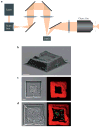Going local: technologies for exploring bacterial microenvironments
- PMID: 23588251
- PMCID: PMC3984535
- DOI: 10.1038/nrmicro3010
Going local: technologies for exploring bacterial microenvironments
Abstract
Microorganisms lead social lives and use coordinated chemical and physical interactions to establish complex communities. Mechanistic insights into these interactions have revealed that there are remarkably intricate systems for coordinating microbial behaviour, but little is known about how these interactions proceed in the spatially organized communities that are found in nature. This Review describes the technologies available for spatially organizing small microbial communities and the analytical methods for characterizing the chemical environment surrounding these communities. Together, these complementary technologies have provided novel insights into the impact of spatial organization on both microbial behaviour and the development of phenotypic heterogeneity within microbial communities.
Conflict of interest statement
The authors declare no competing financial interests.
Figures





References
-
- Hall-Stoodley L, Stoodley P. Biofilm formation and dispersal and the transmission of human pathogens. Trends Microbiol. 2005;13:7–10. - PubMed
-
- Lyons MM, Ward JE, Gaff H, Drake JM, Dobbs FC. Theory of island biogeography on a microscopic scale: organic aggregates as islands for aquatic pathogens. Aquat Microb Ecol. 2010;60:1–13.
-
- Yildiz FH. Processes controlling the transmission of bacterial pathogens in the environment. Res Microbiol. 2007;158:195–202. - PubMed
-
- Pamp S, Sternberg C, Tolker-Nielsen T. Insight into the microbial multicellular lifestyle via flow-cell technology and confocal microscopy. Cytometry A. 2009;75A:90–103. This comprehensive review describes the utility of flow cells and provides a summary of biofilm flow cell studies. - PubMed
Publication types
MeSH terms
Substances
Grants and funding
LinkOut - more resources
Full Text Sources
Other Literature Sources

